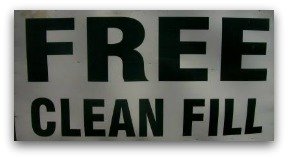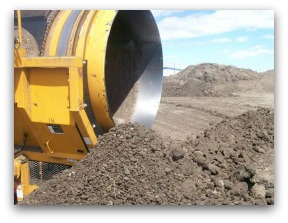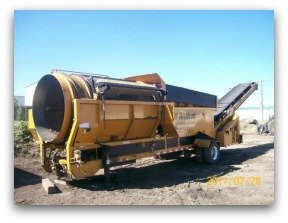C. Estimating Soil
Before we get into estimating soil, we want to go over the importance of
good soil. It seems that there are a lot of people with lawn problems
directly related to their preparation work.
Good soil is the key to it all.
To have a successful lawn for the long term, you need to have good soil composition. Your goal is a nice rich loam. (A healthy balanced mixture of rich organics, sand, clay, and other fine sediments.)
Loam has the ability to take in moisture rather easily, but also retain it once its there. This makes it an ideal soil to work with.
If you have too much clay in your soil, it can lead to compaction problems rather quickly. You will also stand a good chance of experiencing "Runoff" when watering.
Clay soils do not absorb water fast enough and the excess water will build up on top of the lawn. This will cause the water to runoff down the sidewalk, driveway, or street.
If you have too much of a sandy loam, absorption happens fast, but holding that moisture is another issue. Sandy soils drain rather quickly so more frequent watering is needed. Topdressing with organics is one way to improve this type of soil.

Free fill is wonderful...but when you NEED good soil for your landscaping project, BUY good soil.
If you have large debris, rocks, or clumps of sod and clay, they can create voids in your lawn. The soil will settle into the voids over time, leaving you with small sinkholes.
All these things should be removed before you begin estimating soil requirements. We also want to note that rocks over 1 3/4 inches in diameter can impede root growth in your lawn.
Weeds, wood, construction materials, and junk that can come with fill materials can create problems for you as well. Rotting wood below the surface can lead to mushroom problems like fairy rings.
Good soil combined with proper PH and lawn care, will allow you to have a nice, lush, and green lawn. A properly watered and looked after lawn will be thicker and develop deeper roots.
It will be able to combat weeds, drought, heat, cold, pests, and diseases much better. It will also require less chemical treatments and fertilizers saving money and the environment.

This fill material is the by product of screening.
A nice rich loam contains billions of microscopic organisms called microbes.
Microbes turn the building blocks into soluble foods for the root system.
Always take care of your soil by not using harsh chemicals unless you know the consequences of their use.
For those of you that practice organic fertilizing, these microbes are vital in breaking down organic fertilizers into nutrients.
Remember, there is no substitute for good quality soil. Find
yourself a good reputable soil supplier, and do it right the first time.
How to estimate amounts when purchasing soil
Estimating soil is not that difficult if you keep a few things in mind. The first thing to remember is the word itself. "Estimating". This means that it will not be exact. An estimate is only used to get you relatively close.
The second thing you need to consider is the area you are going to use the soil in. This is very rarely a perfect square or rectangle. Don't over complicate your measurements trying to be exact if this is the case.
Square off areas that are rounded or curved. Try to work with straight lines as much as possible, and don't worry about a little bit of guesswork (this is normal).
Accounting for soil Compaction when estimating soil
The third thing that needs to be considered is soil compaction. This can vary from around 15% to 35% depending on the soil, and what you are using it for.
What this means is that you will have to order an additional amount of soil to account for settling and compacting.
Topsoil, fill and clay soils will have less compaction than amended garden soils that contain peat, or other organics. Organics and peat are less dense, and take up more space.

Barrel soil screener.
When soil is loosened up and worked over through a sieve or sifting mechanism called a screener, more spaces are introduced between the particles during this process.
Moisture will also play a part in this equation. Wet soil will compact much more than dry soil.
When the soil is driven over, walked on, and rained on, it will settle. Over time, this will make it difficult for water and oxygen to penetrate the soil to the root zone. That is called compaction, and one of the reasons why we aerate.
We already covered fill materials above. Be aware of these voids
that can be created when using it as a base under your topsoil.
Formula for ordering soil.
This is pretty simple. Take your length x width x depth. This will give you cubic feet of soil required.
Most landscape yards in North America sell soil by the cubic yard, so divide your cubic ft. amount by 27 to convert to cubic yards.
For example:
An area that is 60 by 30 requiring 6 inches of topsoil will look like this. (In the next section we will explain why we base this equation on 6 inches of topsoil.)
- 60 x 30 x .5 (half a foot) = 900 cubic ft.
900 cubic ft divided by 27 = 33.33 yards of soil.
To account for compaction, I would add an additional 25% to this order. 25% of 33 yards is 8.25 yards.
This is a total of 41.25 yards.
Seems like a lot doesn't it? In actual fact, it is only 3 to 4 dump truck loads.
This is not as much as you think. The problem is that most people cut costs when buying soil, and run into lawn problems down the road because of it.
Spending money on expensive chemicals and fertilizers over the next few years will cost more than the cost of one extra load of good quality soil
Remember that a deep rooting healthy lawn also requires less water.
So you need 41 yards of soil? How can you save money ordering soil efficiently? You need to understand how it will be shipped.
Deliveries and Trucking.

Dumptruck and pup-trailer.
Trucks carry 10, 12, and even up to 16 yards of soil depending on the size of the box and the number of axles they have.
Some companies offer truck and pup service. (A dump truck towing an extra trailer, if you need exceptionally large amounts.)
Remember that you have to have adequate room to accommodate this configuration.
When you are purchasing soil, always try to order efficiently. Make orders equivalent to full truck loads when possible.
If you look at the example from above, I would order three truckloads of 12 to 14 yards. This would be plenty of soil for a good lawn base.
Four inches of good soil is the minimum for a healthy lawn, but 6 inches is even better. By using 6 inches in your estimate formula, it allows you to make adjustments to order efficiently without jeopardizing your soil base.
Having to order an extra dump truck and pay the delivery fee for a couple of yards of soil, is just not cost effective.
We really hoped you found this article helpful? If you have any questions, concerns, or comments, we would love to hear from you at our Contact Us page.
Thanks so much,
The Dream-yard Team.
______________________________________
Introduction Estimating Materials
Table of Contents: Landscaping Yards
A. Landscaping Yards Introduction
C. Patio Bricks and Paver Stones
F. Buying Rock
H. Other Landscaping Materials
I. Quick Landscaping Estimating Reference
Table of Contents: Buying Soil
______________________________________
Return to the Estimating Materials Introduction
Go to the Dream Yard Home Page
Check out our time and money saving e-book
How to avoid the biggest mistakes made by DIYers, designers, and landscaping companies.
Visitor
Favorites
Giggles 'n' Thoughts





